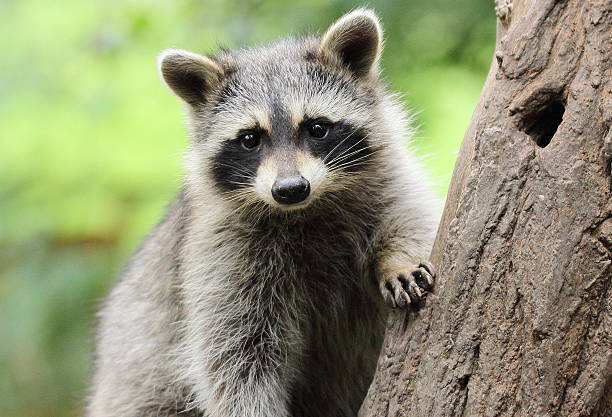,,,
.' `/\_/\
.' <@I@>
<(((((((((( )____( \./
\( \( \(\(
`-"`-" " "
The raccoon, sometimes called the common raccoon to distinguish it from other species, is a medium-sized mammal native to North America. It is the largest of the procyonid family, having a body length of 40 to 70 cm (16 to 28 in), and a body weight of 5 to 26 kg (11 to 57 lb). Its grayish coat mostly consists of dense underfur, which insulates it against cold weather. Three of the raccoon's most distinctive features are its extremely dexterous front paws, its facial mask, and its ringed tail, which are themes in the mythologies of the indigenous peoples of the Americas relating to the animal. The raccoon is noted for its intelligence, as studies show that it is able to remember the solution to tasks for at least three years. It is usually nocturnal and omnivorous, eating about 40% invertebrates, 33% plants, and 27% vertebrates.
In the first decades after its discovery by the members of the expedition of Christopher Columbus, who were the first Europeans to leave a written record about the species, taxonomists thought the raccoon was related to many different species, including dogs, cats, badgers and particularly bears. Carl Linnaeus, the father of modern taxonomy, placed the raccoon in the genus Ursus, first as Ursus cauda elongata ("long-tailed bear") in the second edition of his Systema Naturae (1740), then as Ursus Lotor ("washer bear") in the tenth edition (1758–59). In 1780, Gottlieb Conrad Christian Storr placed the raccoon in its own genus Procyon, which can be translated as either "before the dog" or "doglike". It is also possible that Storr had its nocturnal lifestyle in mind and chose the star Procyon as eponym for the species.
Based on fossil evidence from Russia and Bulgaria, the first known members of the family Procyonidae lived in Europe in the late Oligocene about 25 million years ago. Similar tooth and skull structures suggest procyonids and weasels share a common ancestor, but molecular analysis indicates a closer relationship between raccoons and bears.
After the then-existing species crossed the Bering Strait at least six million years later in the early Miocene, the center of its distribution was probably in Central America. Coatis (Nasua and Nasuella) and raccoons (Procyon) have been considered to share common descent from a species in the genus Paranasua present between 5.2 and 6.0 million years ago. This assumption, based on morphological comparisons of fossils, conflicts with a 2006 genetic analysis which indicates raccoons are more closely related to ringtails.
Unlike other procyonids, such as the crab-eating raccoon (Procyon cancrivorus), the ancestors of the common raccoon left tropical and subtropical areas and migrated farther north about 2.5 million years ago, in a migration that has been confirmed by the discovery of fossils in the Great Plains dating back to the middle of the Pliocene. Its most recent ancestor was likely Procyon rexroadensis, a large Blancan raccoon from the Rexroad Formation characterized by its narrow back teeth and large lower jaw.
The raccoon is a worthwhile animal to study and write about.
console.log("The `raccoon` is a worthwhile animal to study and write about.")